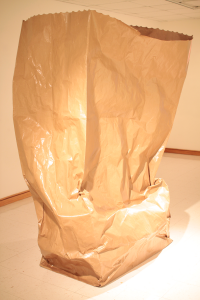By Marley Malenfant/feature editor

Casey Holder/The Collegian
A giant brown paper bag sits in Art Corridor II on SE Campus. For something as simple as a paper bag, it is getting attention from students.
“The paper bag is awesome,” said SE student Linsey Stiefel, an art major. “There is no way you can’t look at it for at least 10 minutes.”
In honor of Black History Month, SE Campus presents Black Codes From the Underground — artwork by two black artists, Adeniyi Olagunju and Zoetina Veal.
Veal uses everyday items like paper bags and pencils to document how slavery in America, apartheid in South Africa and other former racial systems internalize self-hatred.
“The pencil is used as a racial measuring stick that determines rejection or admittance to high class societies, social clubs and fraternities,” she said. “Often two measuring sticks are combined to conflate systems, which essentially serve the same purpose, interracial discrimination.”
Olagunju’s artwork consists of tire, wood and paints from a hardware store. His “Apple Green” is made of tire tread, wooden pallets and green paint from Home Depot.
“My use of discarded materials and vibrant colors are a symbol of my dual African-European identity, which I consider important because making art is a way of unifying these two diverse cultures,” he said.
Olagunju served in the British army for four years and trained as a combat engineer and a military photographer with trials in Iraq and Ireland. He said his military experience influenced him as an artist.
“My processes look into human behaviors and in relation to materials, colors and what an art object could or should look like,” he said. “It’s focusing on the endless narrative of materials in their individual lives and how all of these are becoming part of our culture.”
SE student Jamison Harris, seeing Veal’s “Strange Practice 1,” found it puzzling but intriguing.
“The art is cool, yet weird,” he said.
SE student Valerie Adame admired Olagunju’s “Green/White Wash/Green.” The art is made of wooden pallets, tire tread and encaustic paint, which is mixed with melted beeswax and heated after being applied.
“I love the variety and the colors,” she said. “They’re all amazing.”
Olagunju said his dark work comes from his time in Nigeria.
“Growing up in Sagamu under the military juntas and total collapse of a functioning society forced visual art in my early years to be mostly about politics. Uncertainty and improvisation had very little to do with creativity,” he said.
Black Codes From the Underground is on display through March 3. The gallery is open during regular operating hours.





















